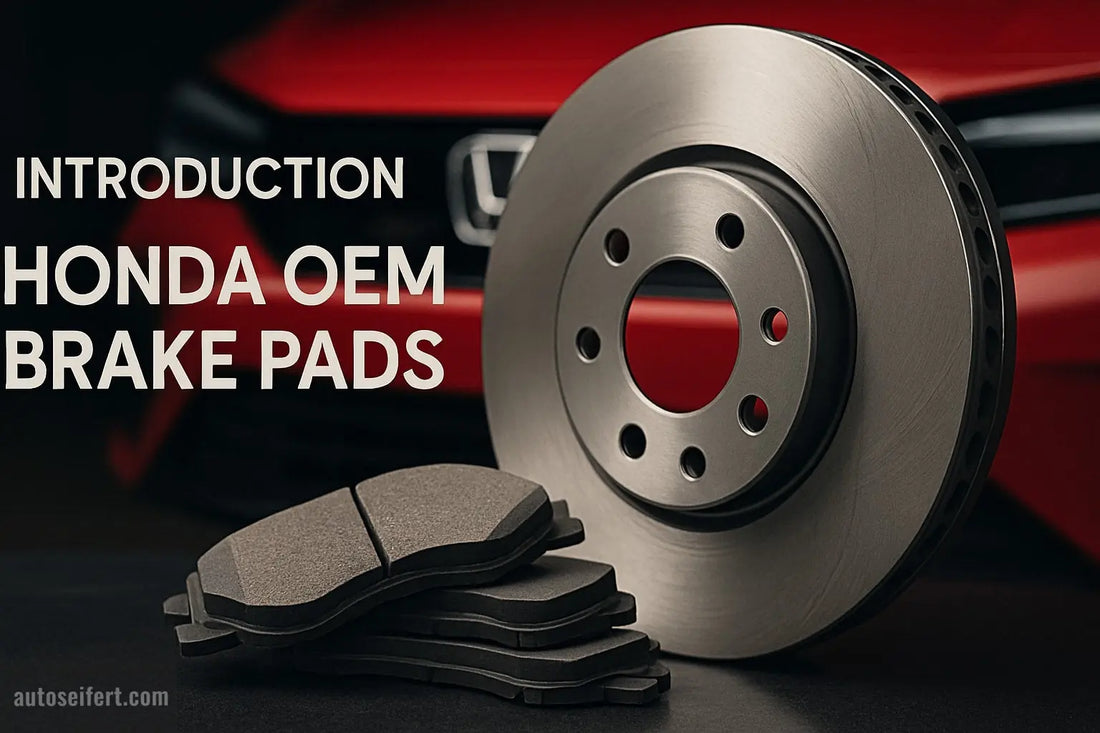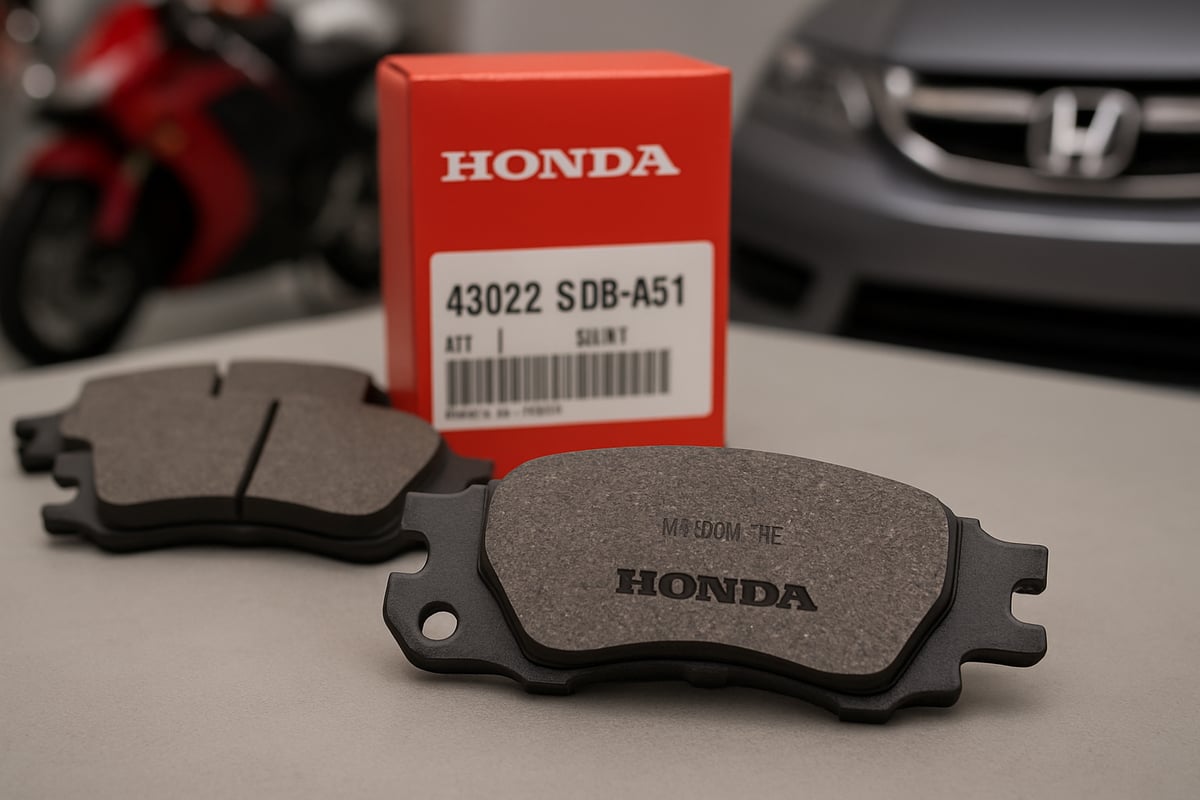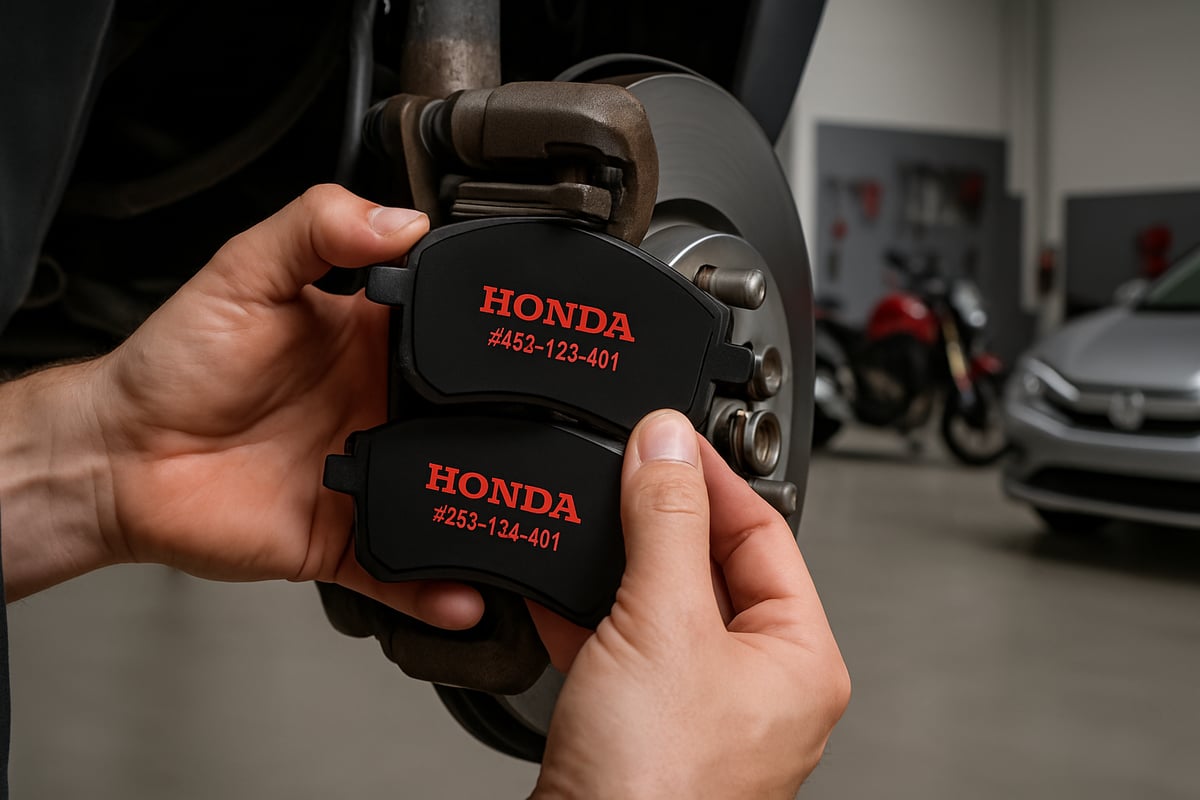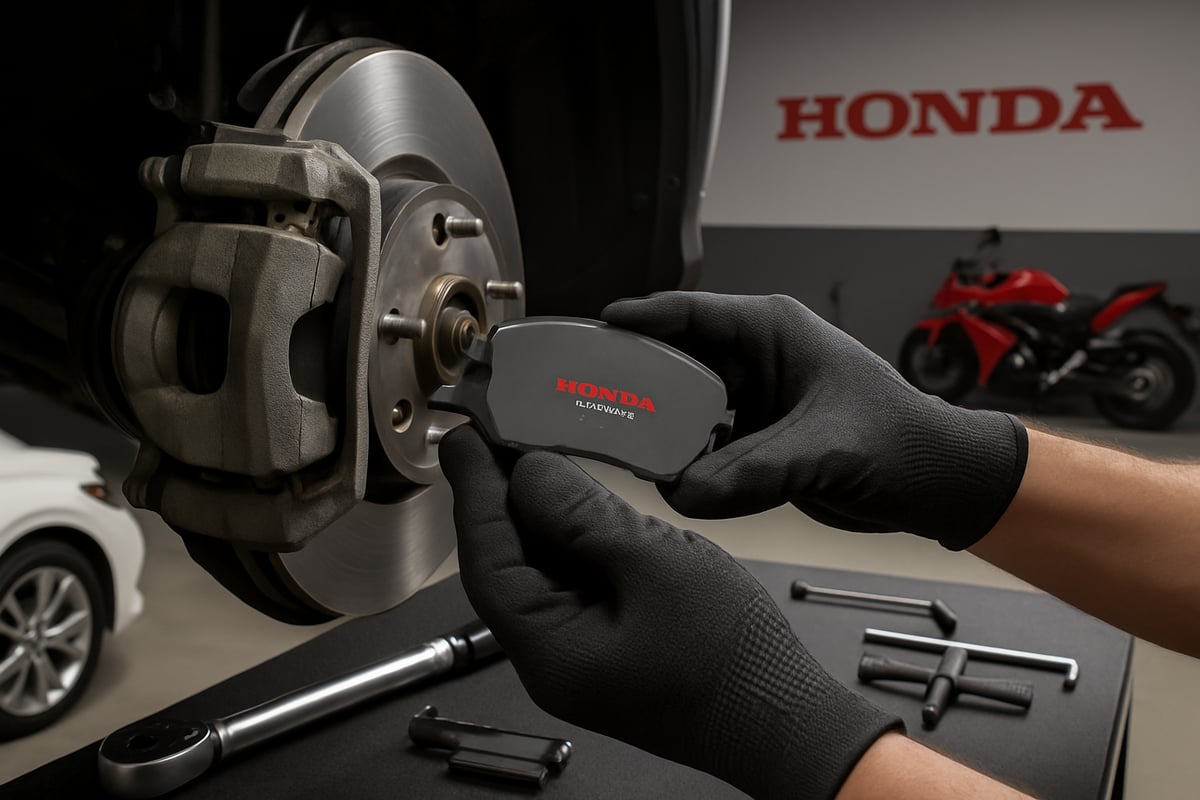
Honda OEM Brake Pads Guide 2025: Genuine Parts Guide
Share
Brake pads are the heart of every Honda vehicle's safety. Their reliability can make all the difference in an emergency. This is precisely where Honda OEM brake pads come into play: They offer the best combination of safety, driving comfort, and value retention in 2025.
In this guide, you'll learn why genuine Honda parts are the smartest choice for maintenance and replacement. We compare OEM and replica parts, offer tips for selection, demonstrate step-by-step installation, and explain how to maximize the lifespan of your brake pads.
Rely on proven quality, experience long-lasting braking performance and make the right decision for your safety and your vehicle.
What are Honda OEM brake pads?
Brake pads are a key safety feature in every Honda vehicle. But what exactly does the term "Honda OEM brake pads" mean? To understand this, it's worth taking a closer look at the meaning of OEM, the structure, and the benefits of these special brake pads for various Honda models.

Definition and meaning of OEM
OEM stands for "Original Equipment Manufacturer," meaning parts produced directly by the vehicle manufacturer or its certified partners. In Honda's case, this means that Honda OEM brake pads are manufactured and tested precisely according to the manufacturer's specifications.
Unlike aftermarket brake pads, which come from third-party manufacturers, OEM parts are specifically designed for Honda vehicles. They guarantee a precise fit, safety, and the preservation of the manufacturer's warranty. The use of Honda OEM brake pads is crucial for maintaining the value of your vehicle.
Structure and materials of Honda OEM brake pads
Honda OEM brake pads are characterized by high-quality materials and precise manufacturing. Depending on the model, ceramic, sintered metal, or organic compounds are used. This choice of materials ensures optimal friction, reduced wear, and minimal noise.
| Material type | OEM brake pads | Aftermarket pads |
|---|---|---|
| pottery | And | Partially |
| Sintermetall | And | Rarely |
| Organic | Optimized mix | Variables |
Specially engineered for Honda braking systems, Honda OEM brake pads offer a longer service life and prevent vibrations. This not only reduces maintenance costs but also ensures a smoother ride.
Advantages of Honda original parts over replicas
Choosing Honda OEM brake pads brings numerous advantages:
- Perfect fit and quick installation
- Retain the full manufacturer's warranty
- Reliable braking performance in all weather conditions
- According to the manufacturer, up to 30% longer service life
- Positive experiences from workshops and drivers
Those who rely on Honda OEM brake pads benefit from consistently high quality and can rely on the safety of their vehicle. An overview of available original parts can also be found at Discover genuine Honda parts.
Relevance for various Honda models (motorcycle & car)
Honda OEM brake pads are available for a wide range of models, including popular motorcycles like the CB 125 R and CBR 125, as well as passenger car models like the Accord and Civic. Compatibility is across all models, but there are specific product numbers like 45022-TE0-A60 for specific vehicles.
The right Honda OEM brake pads are available for various models and models. Especially for new 2025 models, the use of original parts guarantees maximum safety and optimal braking performance. This ensures that your Honda—whether motorcycle or car—will always remain reliable and retain its value.
Why choose Honda OEM brake pads?
Choosing the right brake pads is crucial for your safety and maintaining the value of your Honda vehicle. Especially when it comes to safety-critical components like the brakes, you shouldn't compromise. Below, you'll learn why Honda OEM brake pads are the best choice for your car or motorcycle.

Focus on safety and reliability
Honda OEM brake pads are key components for your vehicle's safety. They are developed according to the strictest quality standards and regularly certified. Through rigorous testing and controls, Honda ensures consistent braking performance under all conditions. A comparison shows that vehicles with Honda OEM brake pads have, on average, significantly shorter stopping distances than those with cheaper imitations.
According to accident statistics, inferior brake pads lead to more critical situations. Drivers also report noticeably better control and less noise. Official information on quality and environmental protection can be found on the Honda original brake pads/brake discs.
Value retention and warranty claims
The use of Honda OEM brake pads contributes significantly to maintaining the value of your vehicle. Genuine parts are a prerequisite for full warranty coverage, as they are precisely tailored to the specifications of your model. In the event of recalls or workshop visits, Honda can verify that only tested components were installed.
This is especially important for leased vehicles or company fleets. Manufacturer recommendations call for the use of original parts to avoid problems during inspections or resale. This ensures a higher residual value in the long term and saves you from potential hassle.
Long-term costs and profitability
At first glance, Honda OEM brake pads appear more expensive than replicas. However, their longer service life and precise workmanship ensure lower running costs. OEM brake pads need to be replaced less frequently, reducing maintenance. Their precise coordination with your Honda's braking system minimizes consequential damage to discs and components.
A sample calculation shows that those who consistently use original parts can save up to 40 percent on repair and maintenance costs over the lifetime of their vehicle. This cost-effectiveness is particularly worthwhile for frequent drivers and fleet operators.
Environmental aspects and sustainability
Honda OEM brake pads are made from environmentally friendly materials and produced under sustainable conditions. The special material blend ensures lower particulate emissions and is fully recyclable. Honda relies on innovative manufacturing processes that conserve resources and reduce CO₂ emissions.
Honda OEM brake pads also offer real added value for environmentally conscious drivers. They combine maximum safety with responsible behavior toward the environment and society. Manufacturer initiatives also promote the return and recycling of used brake pads.
Selecting the right Honda OEM brake pads
Selecting the right Honda OEM brake pads is crucial for your vehicle's safety and optimal braking performance. Anyone who delves into the variety of models, years, and technical differences quickly realizes the importance of accurate information and making the right decision. In the following sections, you'll learn how to find the right brake pads for your Honda model, what to look for in part numbers, and how to avoid mistakes.
Differences depending on model and year of manufacture
When selecting the right Honda OEM brake pads, the model, year of manufacture, and axle play a crucial role. Every Honda model—whether the 2018 CB 125 R, Accord, or Civic—requires specific brake pads that are precisely matched to the braking system and vehicle weight.
Always check whether the front or rear axle is affected and compare the information with the vehicle registration document or the chassis number. Online filters or parts catalogs such as the Brake pads HONDA in original quality, which provides an overview of suitable original parts for numerous Honda models. This way, you can avoid purchasing mistakes and ensure that your braking system functions reliably.
Understanding product numbers and labels
Each set of Honda OEM brake pads has a unique Honda part number, such as HON-06435KTYH51 or 45022-TE0-A60. These numbers can be found in the manual, on the old part, or directly on the brake caliper.
Don't confuse original part numbers with aftermarket references, as they often look similar but are not identical. Also, be aware of differences between European and US part numbers, as small deviations can have a significant impact on fit and safety. If in doubt, check official Honda lists or the parts catalog.
Check compatibility and avoid errors
Selecting the correct Honda OEM brake pads requires care and attention. Common errors arise from incorrect orders due to a change in the year or model. Use a checklist: model, year, axle, part number, and any manufacturer updates.
Before purchasing, also check whether your vehicle is imported or has any modifications. Differences can occur, especially with gray imports, leading to incompatibility. Manufacturer databases and inquiries with the dealer can help avoid incorrect purchases and ensure safety.
Price differences and sources of supply
When comparing Honda OEM brake pads with aftermarket products, it's noticeable that original parts are usually somewhat more expensive. The price differences are explained by higher material quality, longer durability, and the manufacturer's warranty. Factors such as the dealer, shipping method, and current promotions influence the final price.
Purchasing from an authorized Honda dealer offers advantages such as tested, genuine products and personalized advice. Discounts or seasonal promotions can further reduce the price. Sample prices show: For the CB 125 R OEM rear, you'll pay approximately €41.53, and for the Accord front, €183.01. It's always worth comparing prices.
Order Honda original parts conveniently online at autoseifert.com
Anyone looking to order Honda OEM brake pads conveniently, safely, and reliably will benefit from numerous advantages at autoseifert.com. Europe-wide shipping, tested original products, and simple order processing make shopping particularly attractive.

The team offers personalized advice to help you find the right replacement part for your Honda model. Customers praise the service with 5.0 stars for fast delivery and fair prices. If you have any questions about Honda OEM brake pads, simply contact autoseifert.com via WhatsApp, phone, or email and benefit from personalized support.
Installation instructions: How to change Honda OEM brake pads correctly
Replacing Honda OEM brake pads is a key maintenance procedure for every Honda rider. Proper installation not only ensures optimal braking performance, but also preserves the manufacturer's warranty and ensures long-term safety. These instructions will help you replace them efficiently and professionally—for both Honda motorcycles and cars.

Preparation and required tools
Before you begin changing the Honda OEM brake pads, gather all the necessary tools. A well-equipped workstation and appropriate safety measures are essential.
- Tools: Torque wrench, brake piston retractor, screwdriver, socket set, jack, wheel wrench, wire brush, brake cleaner.
- Safety precautions: Jack up the car or motorcycle securely, use wheel chocks, and wear gloves and safety goggles.
- Preparation: Check if the new Honda OEM brake pads fit your model. Check the part number and compare the old and new pads.
- Keep your workspace clean and well-lit. Keep tools and spare parts within easy reach.
A structured start prevents mistakes and saves time. If you are unsure, you can take a look at the Buy HONDA brake pads front and rear Comparison to see differences between OEM and aftermarket.
Step-by-step instructions for changing brake pads
Replacing Honda OEM brake pads involves several clear steps. Proceed methodically to ensure your vehicle's safety.
Step 1: Remove the wheel and expose the brake caliper. Carefully loosen the mounting bolts without damaging the brake line.
Step 2: Remove old brake pads and check their condition. Look for uneven wear or damage to the brake disc.
Step 3: Push the brake piston back using a brake piston retractor. Clean the piston and guide rails with brake cleaner.
Step 4: Install new Honda OEM brake pads. Ensure correct alignment and that all retaining springs are properly seated.
Step 5: Reinstall the brake caliper and tighten the bolts to the torque specified by the manufacturer.
Step 6: Install the wheel and bleed the brake system if necessary. Check the brake fluid level and top up if necessary.
Step 7: After assembly, take a test ride and test the brake function. Listen for noises and check that the pedal or brake lever responds correctly.
Tips: Details such as brake caliper access may vary on the Honda CBR 125 or Accord. Adhering to the manufacturer's specifications is always important, as is using only Honda OEM brake pads for optimal results.
Common mistakes and how to avoid them
When changing Honda OEM brake pads, typical errors often occur that can easily be avoided.
- Wrong pads used: Always check compatibility with model and year of manufacture.
- Assembly errors: Incorrect installation can lead to squeaking, rattling or uneven wear.
- Torque ignored: Screws that are tightened too tightly or too loosely endanger safety.
- Inadequate cleaning: Brake dust and dirt impair function.
- Forgotten control: After installation, check all fasteners and the brake fluid level.
If you follow these points, you will benefit from the full performance of the Honda OEM brake pads and avoid unnecessary follow-up repairs.
Information for motorcyclists and car drivers
Changing the Honda OEM brake pads differs in some details between motorcycles and cars.
- Motorcycle: Often, there's less space, and special tools are required for smaller components. When working on ABS systems, be especially careful to avoid damaging sensors.
- Car: Larger brake calipers, usually more complex mechanics. Look for electronic handbrakes on modern vehicles.
- Security aspects: Motorcycles are more sensitive to incorrect installation, so it is particularly advisable to consult a workshop if you are unsure.
Please note that different break-in periods are required for new pads. For both vehicle types, only Honda OEM brake pads guarantee optimal compatibility with the respective braking system.
Running-in phase and check after the change
After installing the Honda OEM brake pads, the break-in phase begins. During the first 200 kilometers, the braking performance is not yet fully developed.
- Behave: Avoid aggressive braking maneuvers, brake gently and let the material run in.
- Checkpoints: Pay attention to unusual noises, changes in pedal travel, or vibrations.
- Follow-up: After a few kilometers, check the fastening screws and tighten them if necessary.
- Regular visual inspection: Especially in the first few weeks after the change, the Honda OEM brake pads should be visually inspected.
This ensures that the brakes work reliably and that the service life of the Honda OEM brake pads is fully utilized.
Care and maintenance of Honda OEM brake pads
Proper care and maintenance of Honda OEM brake pads is crucial for safety, longevity, and consistent braking performance. Regular inspection and maintenance prevent costly consequential damage and ensure that the braking system always functions optimally.
Regular checks and signs of wear
A regular visual inspection of Honda OEM brake pads is essential. Pay attention to the pad thickness, which should be at least 2 mm on most Honda models. Typical signs of wear include:
- Squeaking or grinding noises when braking
- Noticeable rubbing or vibrations
- Extended braking distance compared to new condition
Honda recommends checking brake pads at least every 10,000 km or at each service interval. Workshops report that consistent checks help vehicle owners avoid brake disc damage and maintain the full performance of Honda OEM brake pads. Further reasons for using genuine parts are discussed in the article. Advantages of Honda Genuine Parts explained in detail.
Cleaning and protection against corrosion
Protecting Honda OEM brake pads from corrosion starts with proper cleaning. Use only cleaners specifically designed for brakes and avoid harsh chemicals that could attack the pads or seals. Regularly removing brake dust and salt is recommended after driving in wet or winter conditions.
- Use a soft brush and a mild brake cleaning spray
- Dry the brake system thoroughly after cleaning
- Check the pads for signs of rust and clean them immediately
This ensures that the Honda OEM brake pads function properly over the long term, especially for seasonal vehicles or vehicles used frequently in harsh weather conditions.
When is a change necessary?
Honda OEM brake pads must be replaced at the latest when the wear limit has been reached, as stated by Honda. Modern vehicles often have mechanical or electronic wear indicators. Delaying replacement can result in damage to the brake discs and a significant loss of performance.
- Covering thickness less than 2 mm
- Unusual noises or poor braking performance
- Visible cracks or discoloration of the surface
Preventive replacement is recommended to ensure safety and maintain value. Statistics show that timely replacement of Honda OEM brake pads can extend the average lifespan of 30,000 to 60,000 km, depending on driving style and model.
Influence of driving style and operating conditions
Driving style has a significant impact on the lifespan of Honda's OEM brake pads. Those who frequently drive in a sporty manner brake harder and need to check the pads more often. Wear is also increased in city traffic, with frequent short trips, or when towing a trailer.
- Sporty driving style: More frequent changes necessary
- Frequent drivers: Shorter intervals for inspection and replacement
- Infrequent drivers: risk of corrosion due to long downtimes
Motorcyclists should pay particular attention to the specific requirements. In the article Motorcycle original spare parts You will find additional information on the care and selection of suitable brake pads for your Honda motorcycle.
Current Honda models and OEM brake pad references 2025
Anyone who relies on Honda OEM brake pads wants maximum safety and reliability for their vehicle. Especially for current Honda models, the right original brake pads are crucial for optimal braking performance and value retention. The following overview shows which models will be in particular demand in 2025 and which OEM part numbers are assigned.
Overview: Popular Honda models and matching OEM brake pads
Demand for Honda OEM brake pads is particularly high for popular models such as the CB 125 R, CBR 125, Accord, Civic, and CR-V. For each model series, Honda offers specially tuned brake pads that are precisely matched to the respective braking system.
| Model | Year of construction | Front axle part number | Rear axle part number |
|---|---|---|---|
| CB 125 R | ab 2018 | HON-06435KTYH51 | HON-06435KTYH51 |
| Accord | 2018-2025 | 45022-TE0-A60 | 43022-T2A-A51 |
| Civic | 2017-2025 | 45022-TBA-A01 | 43022-TBA-A01 |
| CR-V | 2019-2025 | 45022-TLA-A01 | 43022-TLA-A01 |
| CBR 125 | ab 2011 | 06455-KPP-901 | 06435-KPP-901 |
This reference table helps you quickly identify the correct Honda OEM brake pads for your model.
Innovations and technical developments 2025
For the 2025 model year, Honda is focusing on innovative material blends and advanced manufacturing technologies for its OEM brake pads. New generations of brake pads ensure improved braking performance, reduced dust generation, and longer durability.
The most important innovations include:
- Even better heat resistance for sporty models
- Optimized ceramic mixtures for lower particulate matter emissions
- Improved fit through more precise manufacturing
- Longer change intervals due to higher wear resistance
These technical advances make Honda OEM brake pads the first choice for demanding drivers of current and new Honda models.
Experience and user reviews
Many drivers report positive experiences with Honda OEM brake pads. According to surveys, original brake pads receive an average rating of 4.7 out of 5 stars in braking performance, durability, and low noise. Workshops confirm their easy installation and high reliability in everyday use.
The quality of genuine parts is also regularly emphasized in discussions with other Honda riders. The discussion in the Brake pads for various Honda models, OEM, where users share their experiences and tips on using Honda OEM brake pads. This provides interested parties with valuable practical insights and concrete recommendations.
Sources of supply and price development 2025
Honda OEM brake pads can be purchased from authorized Honda dealers and specialized online shops. Prices will remain stable in 2025, with slight fluctuations depending on the model and supplier.
Shopping tips:
- Price comparison between online shop and authorized dealer is worthwhile
- Check offers and promotions regularly
- Pay attention to tested original goods and part numbers
For example, prices for the Accord (front) are around €183, and for the CB 125 R (rear) around €42. Those who choose Honda OEM brake pads are investing in proven quality and long-term safety.
